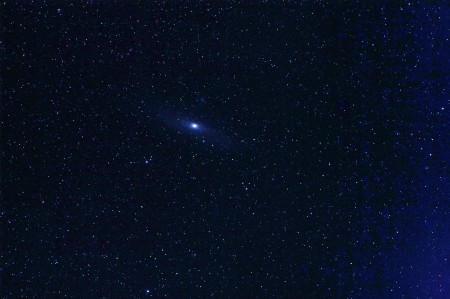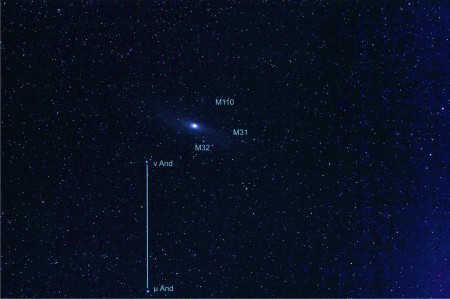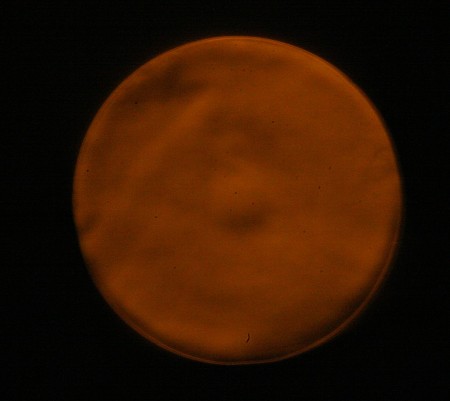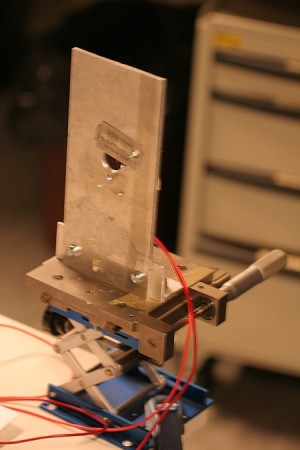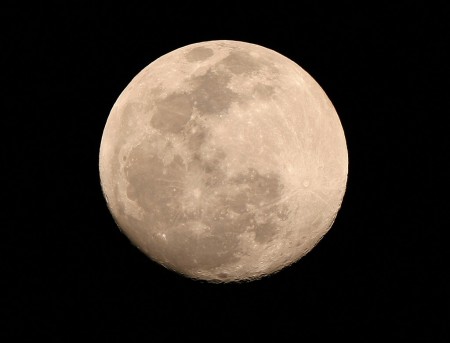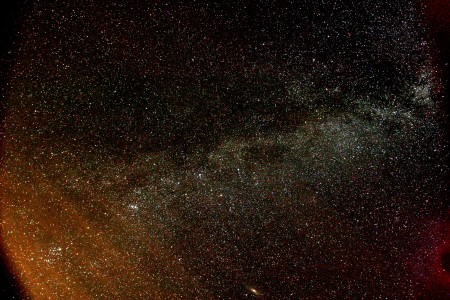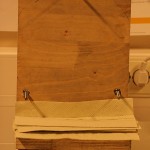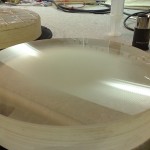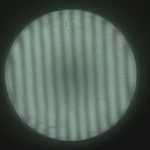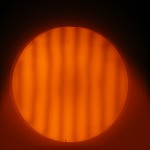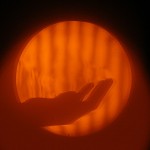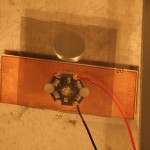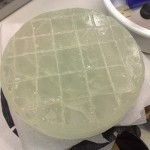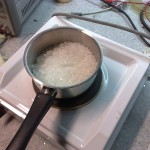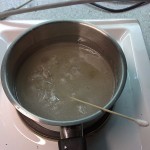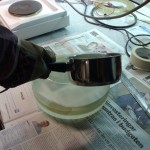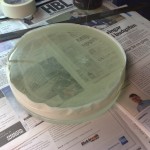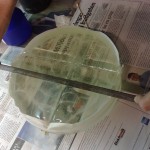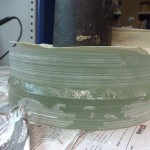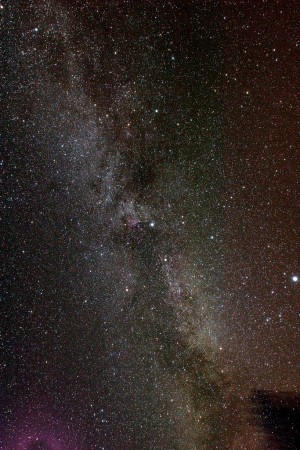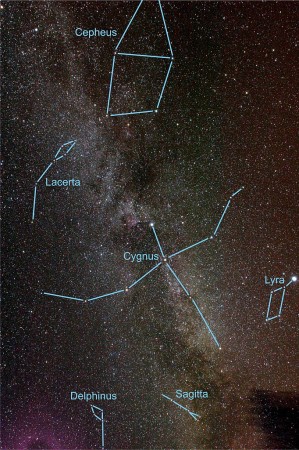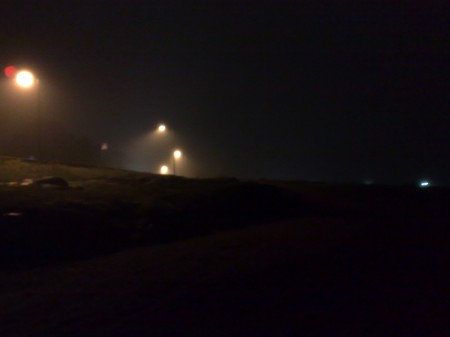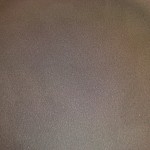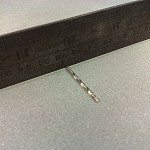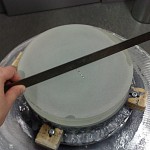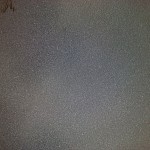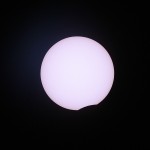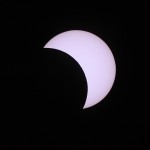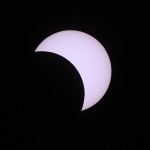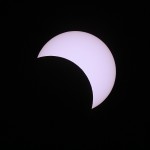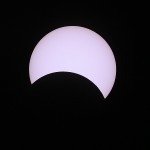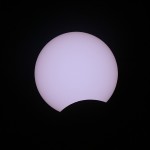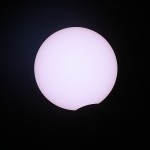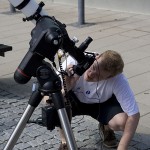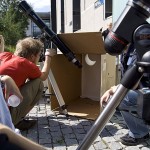The Andromeda galaxy shot with a Canon 20D using a 70-200/4L lens set to 126mm and F/5.6. A stack of 17 frames at iso800, each exposed for 30 secods (total exposure 17x30s = 8.5 min). Unguided EQ-6 mount. A hint of M31's smaller companions M32 and M110 is visible.
Category: Astronomy
Foucault test
Seeing something with the Ronchi test was easy, but the Foucault test proved a bit more demanding. The light-source and the knife-edge need to be securely bolted to the table, and they need to be finely adjustable along the optical axis and perpendicular to the optical axis. The final piece of advice needed to make it work was to sand down the LED used as the light source. The LED then becomes a diffuse suorce, and the knife edge is placed half-way across the LED also.
It turns out that the room we were using for this doesn't have very good 'seeing'. After turning off a printer and some computers that created visible air-current there still remains a lot of disturbances. About the only thing in the photo above that is 'real' and doesn't change with the air-currents is the round spot in the middle.
This is our Foucault tester. The knife edge and light source move along the optical axis using a 50mm-travel translation stage, and everything moves up/down to place the knife edge at the correct height using a small lab jack.
Moon
Cassiopeia
A single 8 minute iso800 exposure of Cassiopeia through a Canon 17-40/4L lens at 17mm and F/5.6. The Andromeda galaxy (M31) is visible at the bottom center.
From the same night as my earlier Cygnus photo. This one is not as good with some light pollution or dew-problems at the left. The red artifact in the lower right corner is the same amplifier noise that's visible in the cygnus photo. My home-made lens hood causes vignetting.
Polishing and Ronchi testing
Polishing is hard work compared to fine grinding. There is much more friction between the lap and the mirror - it's nice to take a break after 15 to 20 minutes of polishing. Possibly due to insufficient pressing our mirror started to polish at the outer edge first. We did about 2 hours of polishing the first evening. Today we started with hot-pressing, i.e. leaving the lap and mirror under hot water for a while and then pressing the two against each other to achieve good contact. After about 1 hour today we did a first Ronchi test, which clearly shows the less well polished spot in the middle. One more hour of polishing and we are up to about 4 h in total. There's still a hint of the less well polished area in the middle. Looking at the Ronchi test the overall shape of the mirror is roughly spherical as it should.
Our Ronchi tester consists of a wooden mirror stand made from plywood with three long M6 bolts to hold the mirror. We're using an LED as a light source, and the 100 lines per inch grating is printed on an overhead-slide with a laser printer.
The radius of curvature is roughly 288 cm indicating a focal length of 144 cm which would make for a focal ratio of F/6.
Making a Pitch Lap
Fine-grinding of the mirror has progressed without problems. Around 1.5 hours of work per grit-size was enough to achieve a uniform surface roughness. After the finest grit, 15 micron Aluminium oxide in our case, it's time to polish the mirror using a Pitch lap and cerium oxide.
We heated around 500g of pitch on an electric plate. Note the tube that sucks away the fumes (normally used when soldering). Pitch is an interesting material to play around with, hard and brittle when cold, almost as runny as water when hot, and all kinds of viscosities and 'feel' in between. The mirror and glass tool were heated in an oven to around 65 C and a dam of paper masking tape was added to the tool. After pouring the pitch we waited for it to cool a bit and then made some channels using a steel ruler. Then the lap was pressed, mirror on top, with water and soap covering the surfaces to avoid sticking. Finally when the lap had cooled using a sharp knife the edges were bevelled and the channels re-opened.
About 10 hours of polishing now follows...
Cygnus
A 32 minute exposure at iso200 through a Canon 17-40/4L (17mm @ F/5.6) of Cygnus and surrouding constellations with the milky way in the background.
There is a tree at the bottom right, and some local light-pollution bottom left, otherwise I am quite happy with this first serious go at a wide-field milky way picture. A dew-heater will allow longer uninterrupted sessions, and the fine focus could be improved slightly. Perhaps I should use a higher iso setting?
Update: after some discussion it seems that the red problems in the lower left corner may be due to amplifier-noise in the camera. Stacking a number of shorter exposures, for example 6x 10 min, is a better way of achieving a long total exposure with a DSLR. Cooled CCD cameras made for astrophotography are better for very long exposures - but also cost significantly more than consumer DSLRs.
Fog instead of a lunar eclipse
In contrast to the recent partial solar eclipse southern Finland didn't see much of this evenings partial lunar eclipse. It wasn't outright raining, but the amount of water in the air prevented any view of the moon, eclipsed or not. It should have looked something like this.
Rough grinding continues
Started out this evening with a 1 mm sagitta on the 240 mm mirror.
Started with no60 carborundum and ca. 20 + 30 min of grinding, which got us down to a 1.9-2.0 mm sagitta. The picture shows a 2.0mm drill bit under a steel ruler used for measuring the sagitta. The surface of the mirror is quite rough and appears white when dry.
Switched to no80 carborundum. Grinding is now much smoother with the mirror gliding easily across the tool with less sticking events. After about 30+30 min of grinding we are down to a 2.3 mm sagitta. A quick-and-dirty test shows around a 3 m radius of curvature. Surface now smoother to the touch, still white when dry.
Next stop: build a Focault-test/Ronchi-test jig to properly measure the focal length and the shape of the mirror (see for example plans here). Think about moving down to no150 carborundum.
Partial Solar Eclipse
Today's partial solar eclipse happened from 11:44 to 13:55 local time, so we combined observing the eclipse with a lunch-picnic for the whole lab.
One telescope with a 25mm positive lens at the eye-piece projected an image of the sun into a cardboard box. Another was used with a tracking mount and an OD=5 solar filter for visual observations and photography.
It was cloudy before the eclipse and rainy in the afternoon so we were lucky with the weather!
Variations on the same theme:
